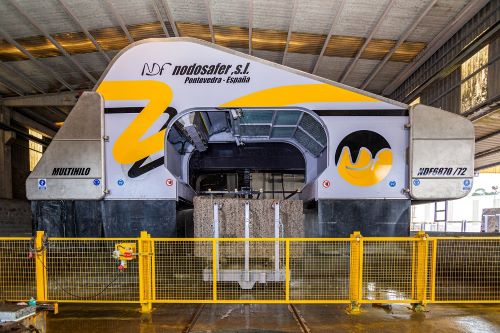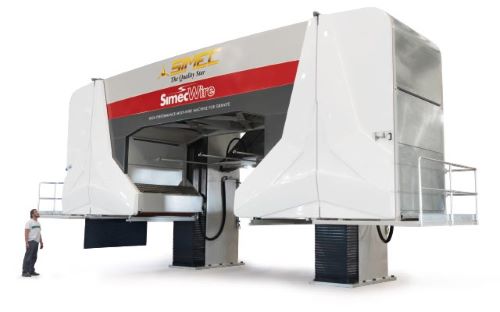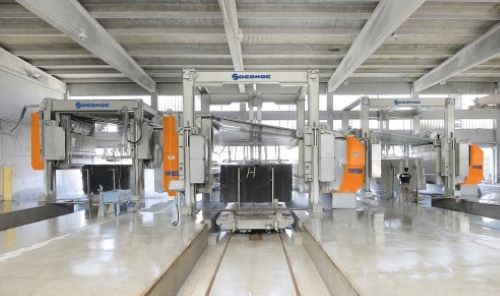Technological advances in the stone industry tend to be steady improvements of all kinds instead of being disruptive. This is the case with multiwire machines for processing blocks where the machines of today have superior performances compared the ones a decade ago. A series of questions were sent by this magazine to different multiwire machines manufacturers, below we publish the replies received by us from some of them.
NODOSAFER

Mod.68/70 Nodosafer
1.- Is your machine supported on 2 or 4 columns?
Machine supported on 2 columns. Columns that mount large diameter helical ball screws, a group of preloaded skids and also, we mount servo motors synchronized by software in the vertical movements.
2.- Describe briefly the tension system for the wire in the machine. Is it individual or collective, hydraulic, mechanical, pneumatic...?
Double hydraulic tensioning, one for approach and the second with a patented STA system that individually controls the arrow that describes each wire individually
3.- How is the deterioration and performance of the wire controlled?
Through the STA system, the tension of each wire is continuously controlled individually, making them self-manage automatically in the face of different circumstances that may appear in the block cutting process. That allows all the wires to work perfectly in parallel and we avoid those block completion waits.
4.- How many wires are mounted on the machine and why?
We assemble from 15 wires to 72 wires for GRANITE, differentiating the machines if they are going to cut with a 7.3 mm or 6.3 mm diameter wire
For MARBLE we work with 5.3 mm diameter wire and we have 3 models
We are currently launching the 1.40m drum machine (for the block width of 1.40m) its 20 wires in response to the request of a large number of customers.
5.- What is the monthly production?
The monthly production of the multiwires will depend to a great extent on the size of the machine, the thickness of the boards to be cut, the working hours of each of the clients ... in working conditions of 24 hours-365 days, our machines have a production significantly important in relation to the sector.
Right now we already have availability to cut 12mm-20mm-30mm and higher thicknesses
6.- As an objective data, what is the average consumption of the wire in m2/ml ? In Euros/ml?
Like the previous question, we are talking about a multitude of variables that do not allow us to quantify these data objectively. Simply indicate that any manufacturer of a quality diamond wire works confidently, safely and calmly with our multiwires.
7.- What characteristics allow the machine to obtain these consumption levels and what other characteristics would you like to highlight?
NODOSAFER multiwire machines, above all, are characterized by their robustness, by their structure. The very design of the machine allows a perfect quality of cut thanks to the fact that large diameter helical ball screws are mounted for a smooth and precise movement, servo motors synchronized by software in the vertical movements that ensure smoothness in the cut, group of sliding skids , low consumption and above all, the patented STA tensioning system, an active system with automatic individual control of the arrow of each of the wires, reacting in milliseconds to any unwanted variation in the cut.
Also, our multiwires can reach peripheral speeds much higher than average due to the design and structure of the machine. On many occasions, the block to be cut needs that peak of speed that our equipment can achieve without any problem of vibrations, reverberations or affect the quality and flatness of the cut. This interaction between the machine and the stone allows us to obtain the best possible results when cutting the blocks.
8.-. What KW/wire does the machine have?
All our machines are oversized so that the electric motor never exceeds 60-70% of the available capacity, therefore the cut is very smooth and continuous, without alterations due to overheating, excess torque, etc ...
9.- What is the thickness of the wire that can be mounted on the machine?
We currently work in granite with 7.3 and 6.3 mm wire and in marble with 5.3 mm wire.
The design of our machines allows, with a few small transformations, that a machine that is put into operation prepared for 7.3 mm wire, can work when the client so requests with wires of smaller diameter (6.3-5.3) and even if the wire technology and you get to work on a wire with a diameter of 4.3 mm, our machines are already pre-designed to adapt to any type of wire diameter.
10.-. What is the length of the wire that is mounted on the machine?
We have two options, 25.4 meters and the latest generation machines mount 23.5 meters
PEDRINI
Multiwire Jupiter Pedrini
1.- Is your machine supported on 2 or 4 columns?
The structure of the Pedrini Multiwire Jupiter is composed of two columns strongly fixed to foundations and one connecting "Arco" structure, that have been built with wide closed section in large thickness normalized steelwork. The 2 columns construction has been designed in order to have easy, rapid and ergonomic access for the operations of wires replacement/displacement. All the structural parts have undergone structural checks in accordance with FEM (Finite Elements Methods).
2.- Describe briefly the tension system for the wire in the machine. Is it individual or collective, hydraulic, mechanical, pneumatic... ?
The individual tensioning action of the wires is powered through one oleo-dynamic system. The wire tensioning system performs the movement necessary for diamond wires replacement and repositioning to change the slabs thickness; it keeps the constant programmed tension on each wire and individually compensates its stretching during the cut.
3.- How is the deterioration and the performance of the wire controlled?
PLC controls the start of the cutting cycle by gradually increasing the down-feed up to the programmed value. The PLC actuates and controls machine quick stop cycle in case of water black out. A software function allows to program a certain limit value of electrical current per each wire. The limit value is chosen, according to experience, in order to not deteriorate the wire. By this function the machine adapts automatically the down-feed speed according to the electrical current measurement, in order to not exceed the programmed limit. The tension of the wire is controlled and visualized on the control panel.
4.- How many wires are mounted on your machine, and why?
Pedrini manufactured the biggest Multiwire machine, the worldwide first ever 108 diamond wires machine, to cut granite blocks into 12mm-thick slabs. Pedrini Multiwire Jupiter models, for producing standard slabs thickness, are manufactured according to multiple of 8 wires, from 16 to 80. The machines with 64 – 72 – 80 wires are manufactured to cut 1 entire block for each cutting cycle. The other models, with less wires, are manufactured to cut the block with multiple cycles.
5.- What is the average monthly production of the machine?
Making reference to a Multiwire Jupiter machine with 72 diamond wires, the average processing capacity is as follows: 2/3 blocks of granite per day or, in case of marble, 8/9 blocks of marble per day The production of the machine depends on the type and hardness of the stone blocks.
6.- As objective data, what is the average consumption in m2/ ml ?In euros/ml?
The wire yield in m2 of slabs for each meter of wire depends mainly on the variation of the hardness of the stone blocks. Generally, the more is the hardness the less is the yield. Pedrini Multiwire machines are recognized by the international market for having the maximum yield.
7.- What characteristics allow your machines to obtain these consumption levels, and what characteristics of your machines would like to highlight?
Pedrini Multiwire Jupiter is a high-tech machine with exclusive and advanced patents relevant to: - Wire tensioning system and pulleys - Cooling/washing system - Special coverage on the flywheel. Moreover, Pedrini constantly evolves and innovates its projects and designs to maximize the wire performance level.
8.- What KW/wire does the machine have?
To size the main motor of Pedrini Multiwire Jupiter machine we consider the following range of values: - Granite from 2,75 KW/wire to 4 KW/wire; - Marble from 5 KW/wire to 6 KW/wire.
9.- What is the thickness of the wire that can be mounted on the machine?
The wire thickness is: 4,3 mm – 5,3 mm – 6,3 mm – 7,3 mm
10. What is the length of the wire that is mounted on the machine?
The length of the wire is 24,5 m
SIMEC

Simec SW 2000
1.- Is your machine supported on 2 or 4 columns?
The machine architecture consists of a fixed part with two columns in which the sliders that support the "arch" cutting frame slide vertically.
2.- Describe briefly the tension system for the wire in the machine. Is it individual or collective, hydraulic, mechanical, pneumatic...?
The tensioning system is designed to tension the diamond wires in a constant and punctual manner during all phases of work in order to make the most of the wire's sharpness until it is completely worn out. The system is composed by two parts: one that moves the entire group of tensioning pulleys in order to facilitate the installation of the wires on the gangsaw; the other that controls the precision of the tensioning wire by wire. Both systems are hydraulic. The first through two large diameter cylinders, the second through small short stroke cylinders electronically controlled with proportional technique, managed by the machine control software.
3.- How is the deterioration and performance of the wire controlled?
The SW project adopts various expedients that contribute to enhance the performance of the wire. (hourly productivity and yield):
structure rigidity;
wire path;
tensioning system.
4.- How many wires are mounted on the machine and why?
SW machines are available in different cutting widths to better suit the specific needs of our customers. In addition, each useful cutting width can be configured to work with wires of different diameters and positioned at different distances from each other.
In this way, there is a multiplicity of different versions, that can reach a maximum numbers of wires installable of 80.
Cutting width: 2200 mm; 2000 mm; 1200 mm; 900 mm
Nominal wire diameter: 7.3 mm; 6.3 mm; 5.3 mm.
5.- What is the monthly production?
It is difficult to give a precise answer to this question because there are many variables that contribute to define this data:
type of material;
Block dimensions;
mix of thicknesses produced
machine model
use of the machine production capacity, average number of wires/max number of wires installable
number of daily shifts: 1-2 or 3
type of wire used.
In a hypothesis of a SW 2000 machine with 74 wires with diameter 5.3mm, working on material of hardness 3 on the Mohs scale, with a good exploitation of its production capacity, it can exceed a monthly production of 20,000 m^2.
6.- As an objective data, what is the average consumption of the wire in m2/ml? In Euros/ml?
This figure depends on the diameter and brand of the wires used; on our machines we reached 17-18 m2/ml
7.- What characteristics allow the machine to obtain these consumption levels and what other characteristics would you like to highlight?
structure rigidity;
wire path;
8.- What KW/wire does the machine have?
3.4 ÷ 3.8 kw/wire
9.- What is the thickness of the wire that can be mounted on the machine?
Nominal wire diameter: 7.3 mm; 6.3 mm; 5.3 mm.
10.- What is the length of the wire that is mounted on the machine?
24.5 m
SOCOMAC

Socomac 70 wires
1.- Is your machine supported on 2 or 4 columns?
4 columns
2.- Describe briefly the tension system for the wire in the machine. Is it individual or collective, hydraulic, mechanical, pneumatic... ?
It is individual and hydraulic
3.- How is the deterioration and performance of the wire controlled?
Through consumption in KW
4.- How many wires are mounted on the machine and why?
70/72 for 2 metres cut. 84/90 for 2.4 metres width
5.- What is the monthly production?
In the company EuroCKP (Spain) the average production is 2.2 blocks per day.
6.- As an objective data, what is the average consumption of the wire in m2/ml? In Euros/ml?
Average consumption of the wire is 8-12 mq/ml. Euros 0.4/ml.
7.- What characteristics allow the machine to obtain these consumption levels and what other characteristics would you like to highlight?
The tensioning is very precise. The best characteristic of our machine is its low maintenance cost achieved with a special anti friction system through idle pulleys that avoids the use of bearings.
8. What KW/wire does the machine have?
Works with 1.2/ 1.4 KW per wire depending on the diameter of the wire.
9.- What is the thickness of the wire that can be mounted on the machine?
5,3 – 6,3 – 7,3
10. What is the length of the wire that is mounted on the machine?
21,60 ml
